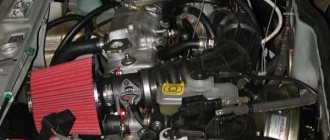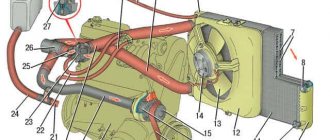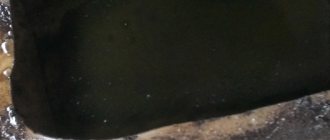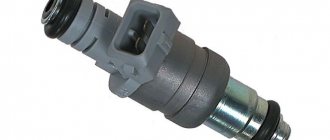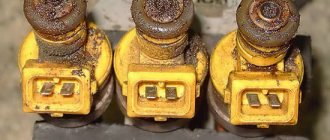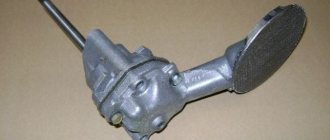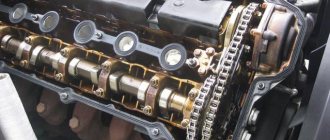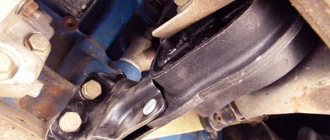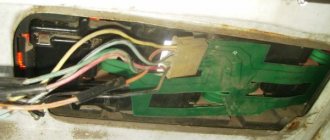It is strongly recommended to flush the engine in such cases.
Changing the brand and type of oil . If the oils are incompatible with each other or their viscosity index and additive set are radically different, you are unlikely to avoid flushing the engine. The fact is that mixing motor oils is not recommended at all, and if they are, among other things, incompatible with each other, then flushing in this case will prevent sad consequences.
Switching from synthetics to semi-synthetics and vice versa. If you want to change the type of oil to one or another that differs in composition and type, flushing the engine will avoid mixing and the formation of unwanted chemical reactions as a result. When heated, oil elements can interact with each other, forming new chemical chains that negatively affect the condition of engine parts and the entire engine as a whole.
The "dark past" of the car . If you bought a car secondhand, and you did not check with the former owner what exactly he poured into the engine of your new car, or you simply do not trust this person, it is better to play it safe and flush the engine. It is also not uncommon after a purchase that it turns out that the previous owner did not fill the engine with the oil recommended by the manufacturer; in this case, we are talking as much about the manufacturer of the engine oil as about its specifications and set of additives.
After engine overhaul . In the event of a malfunction for one reason or another and the need for major repairs, after completing all restoration work, it is recommended to flush the engine. This is done to clean the working surfaces of the power unit from technical debris.
Motor contamination . If you mistakenly poured bad oil into the engine or one that is contraindicated by the manufacturer, low-quality or inappropriate antifreeze, or the same fuel, it is recommended to flush the engine using a special flushing compound.
When to clean the engine
Flushing the engine with kerosene before replacing should not be done every time, as many service stations recommend, hoping to earn more money from you. The need for cleaning is determined based on the vehicle's mileage. As a rule, it is recommended to clean the engine every 70-80 thousand mileage. But in fact, no one does this, so to make control easier, we’ll set the bar at 100 thousand mileage. During this time, the surface and insides of the parts become overgrown with smudges and smoke, which must be removed, because all this reduces the power of the engine and affects its operation.
Is it always necessary to flush the engine before changing the oil?
Engine deposits occur for the following reasons:
- use of counterfeit oil or oil with inappropriate characteristics;
- violation of the oil change interval, oil change according to modern regulations (15-30 thousand km);
- engine wear, which causes a large amount of exhaust gases to enter the crankcase.
If you plan to change the oil again, you should evaluate the degree of contamination of the power unit. To do this, you need to remove the filler cap and find out the degree of cleanliness of the parts. If there is no obvious contamination in the form of thick deposits, then there is no need to flush the engine.
If there are a lot of deposits, then it’s worth thinking about - maybe you don’t need to flush the engine, but remove the valve cover and the lower part of the engine crankcase, and manually remove all the dirt that your hand can reach.
This is not a major overhaul, the cost is 2 gaskets and a day of work. This way, most of the deposits will be removed and will not clog small-diameter technological lubrication channels. Accordingly, the risk of early engine failure is minimized.
Why is flushing necessary?
Failure to flush the cooling system in a timely manner can lead to the radiator becoming clogged over time. Refrigerant wear products, corrosive residues, scale that appears as a result of using water instead of antifreeze - sooner or later this will contribute to a decrease in the performance of the radiator.
Failure of this element will result in problems with the operation of the engine, which, of course, will affect the functioning of the car as a whole. So flushing the engine cooling system is a process that should not be neglected, at least in order to protect your radiator. The procedure should be carried out at least once every two years, and the recommendations of the car manufacturer should be taken into account. By observing this frequency, you can prevent the formation of refrigerant wear and corrosion in the system.
Using engine oil
Advice: Do not fill an engine that makes knocking or noise with expensive oil. You must first diagnose the device.
The opinion that if you rarely drive a car, then the oil does not need to be changed, does not correspond. If the engine is not started for a long time, condensation will collect inside, which, when mixed with oil, worsens its properties and increases wear on rubbing parts. So:
- You cannot start abruptly from a stop and accelerate the car too much, which also increases wear on parts.
- There are functional features of the oil. “Winter” should not be poured in summer and vice versa.
- The quality of the fuel used plays a role in the deterioration of oil properties. Residues of fuel that does not burn completely end up in the oil, which contaminates it.
Flushing Recommendations
Today in our car stores you can find many different products and liquids for flushing the cooling system. Many car enthusiasts mistakenly believe that the best option is to use distilled water, but this is far from the case. Ordinary liquid contains a large amount of salts, which, as a result of washing, form scale on the internal walls of the system elements.
Special equipment
The range of specialized cleaning products is quite huge - liquids with different compositions and concentrations can be found on sale. However, you need to pay attention to the choice of cleanser, since different products should be used to remove different types of contaminants. In general, such liquids are divided into several types:
- Neutral products contain no aggressive elements. It is better to use such products for preventive purposes, since they are not very effective for flushing directly.
- The composition of acid additives is very aggressive, so they are not sold in their pure form. Usually used by specialists to remove scale from the cooling system.
- Alkaline products have an aggressive composition and are designed to remove organic formations.
- In the case of two-element products containing alkali and acid, flushing allows you to remove almost all types of contaminants from the cooling system.
Experts do not recommend using several types of liquids at the same time because alkali and acid can be neutralized by each other when interacting. Accordingly, this will not bring the desired result. We also do not recommend using too concentrated products, as this may cause the liquid to corrode the rubber and plastic components of the system.
Traditional methods
Cleaning the cooling system with citric acid is an old flushing method that has been used by domestic motorists for decades. If the proportions are correct, then citric acid will allow you to optimally remove scale from the radiator, without negatively affecting rubber and plastic. According to experienced motorists, you will need about 100 grams of citric acid per 1 liter of distillate. But keep in mind that no one is responsible for the effectiveness of the method, so all responsibility falls on you.
Car enthusiasts also practice using regular cleaning serum instead of citric acid. According to those who practice this method regularly, the composition of the serum allows for effective and, importantly, gentle flushing of the car’s cooling system. As in the previous case, the serum will not destroy rubber and plastic elements. According to experts, this procedure should be carried out in two or three short approaches - this will allow the system to be flushed most effectively.
"Coca Cola"
There are different opinions among our car enthusiasts about Coca-Cola. One claims that thanks to aggressive components, such as phosphoric acid, included in the drink, Coca-Cola can effectively remove all dirt and scale from the elements of the car’s cooling system. According to others, such an aggressive drink should be used very carefully, or better not used at all, since sugar, which is in excess in the composition, will only contribute to clogging of the pipes. So if you decide to use the drink, then after it in any case you need to use the distillate again to eliminate sugar residues.
Also, the drink can damage the car due to the presence of gas in it. Since gas tends to expand when interacting with the heat of a car engine, this can cause certain problems. So in case you don't have the right products on hand to clean the system, but you have a nosebleed, you need to do it, get rid of the gas in your drink. Open it and leave it with the cap open for an hour. The longer, the more gases will come out of the bottle.
Coca-Cola for rinsing
Types of Radiator Cleaning
The radiator is the main unit of the cooling system of any “iron horse”. Therefore, effective cleaning depends 50% on its condition. It is produced in two options:
- Internal – removes rust deposits, scale and any other types of pollution. Often carried out after using ordinary water as a coolant, which contributes to the appearance of a salt layer.
- External - on the VAZ 2114, thanks to open access to the radiator body, it is possible to carry out the procedure without removing the unit. Contaminants (dust, dirt, insects, etc.) are removed using a powerful water jet.
When is engine flushing contraindicated? Disadvantages of flushing
Most motorists sincerely believe in the miracles and miraculous abilities of flushing fluids, as well as oil additives. In their opinion, in order to solve this or that problem associated with unstable or incorrect operation of the motor, it is enough to buy an expensive flush or additive. However, in reality, everything turns out to be the opposite: after such chemistry, the engine completely becomes unusable or, instead of improving its condition, the problem only gets worse.
So, when is it better to stop flushing the engine?
When flushing, some of the old oil with the flushing fluid remains in the engine, since you will not be able to drain it all. In view of this, we can safely say that flushing the engine during a routine oil change is not only an extra waste of time and money, but also dilutes the new oil. Nothing bad, of course, will happen, but there won’t be much benefit either, so there’s no point in flushing the engine every time you change the oil.
The second disadvantage is caustic substances. Flushing liquids, as a rule, are poured in for a short period of time; this is explained not only by convenience, but also by the composition of the flushing itself. The fact is that the liquid contains a set of aggressive detergents that actively affect contaminants, as well as other parts of the engine parts. For this reason, excessive care of the engine in the form of regular flushing can result in problems associated with leaking oil seals and gaskets, as well as leaks in other parts of the power unit. Moreover, as you already know, part of the flushing remains in the engine, so even after changing the oil, the engine will be exposed to the aggressive effects of detergent additives. How this will affect the condition of the engine can only be guessed at, but one thing is for sure - frequent flushing is more harmful than beneficial.
Relevant : Flushing the cooling system: methods, nuances, results
What cleaning methods are there?
Flushing the engine with kerosene before changing the oil can be done in other ways, more gentle and faster. Gentle cleaning is a more suitable option, because it does not cause any harm to the car. This is a fairly common cleansing practice. A special cleaning liquid is poured into the engine block and left there for a while, and with this liquid the car must cover 150-200 km.
Flushing the engine before changing the oil, a video of which you can view in the article, can be done periodically.
When the car has covered the required distance, it is returned to the service center, where the liquid is already drained, and along with it all the fumes and pieces of burnt material come out. As a result, the motor will work better and quieter, reception will be normalized and without interruptions, and elasticity will increase. With this procedure, it is also recommended to install new filters.
How to flush the engine when changing the oil
If a flushing additive is used, it is poured through the oil filler hole. The engine is started and allowed to run for the time recommended by the manufacturer of the flushing composition. Then the engine is turned off, the old oil is drained, the oil filter is replaced and new oil is added.
If flushing oil is used, then the old motor oil is drained and flushing oil is added. Then drive the car for the washing distance recommended by the manufacturer. Afterwards the oil is drained, the oil filter is changed and new oil is added.
What kind of oil can be poured into the VAZ 2107 engine
A car owner who decides to change the oil on his “Seven” for the first time will inevitably face the question: which lubricant to choose? This is not an idle question, because there is a huge amount of motor oils on the modern market. It doesn’t take long to get confused by such abundance. Therefore, it is worth understanding the types of motor oils and their differences.
Types of oils
Essentially, engine oils are divided into three types:
- synthetic oil;
- semi-synthetic oil;
- mineral oil.
Now let's look at each type of oil in more detail:
- Synthetic motor oils are the most expensive. This should not be surprising: “synthetics” have excellent temperature parameters and viscosity. If the driver has filled in with high-quality synthetic oil, he can be sure that it will not freeze even at -50°C, and this circumstance is very useful given our climate;
- Semi-synthetic motor oils are a mixture of mineral and synthetic oils. “Semi-synthetics” do not have such a wide range of operating temperatures, but they have one undoubted advantage: they are cheaper;
- Mineral motor oils are the cheapest today. The reason is simple: the viscosity of these oils directly depends on the outside temperature. For example, at forty-degree frost, most mineral oils turn into a substance similar to plasticine.
Stages of replacing lubricant VAZ 2107
On classic Lada cars or the more familiar Zhiguli, a convenient drainage of used oil from the engine is provided. The oil filter is also easily accessible and can be reached from the engine compartment.
During the production of the VAZ 2107, a large number of modifications were produced, which were equipped with various engines. Experienced drivers note good maintainability, unpretentiousness in maintenance, as well as consumables.
Before starting to replace the lubricant, precautions should be taken. It should be noted that the drained waste will be at a high temperature. Since the replacement is carried out on a warm engine.
Draining waste fluid
Before starting the draining procedure, you should prepare tools, empty containers, as well as new liquids for subsequent filling. If additional protection is installed under the engine, it can also be removed for convenience.
Next, we perform the procedure for draining the liquid from the VAZ 2107:
- We lift the hood, under it we find the filler neck on the engine and unscrew the plug (Fig. 1).
Fig.1 Oil filler neck
Now we go down under the car and place a waste container in the drainage area. You can use a cut canister or an old bucket. Unscrew the drain plug using a 12mm hex key (Fig. 2).
Fig. 2 Drain plug The drain plug is not always located at the lowest point, so about 100-200 milliliters of waste may remain in the pan. To remove them, you can use a rubber bulb or a syringe with a hose attached to it (Fig. 3).
Fig. 3 Pumping out residues with a syringe Now you need to unscrew the old oil filter, which is located on the right side of the engine under the hood (Fig. 4).
Fig.4 Oil filter
To unscrew the filter element, it is advisable to have a special puller. If it is not available, you can try to unscrew the filter using improvised means. In this case, you can use, for example, an old alternator belt, a regular belt, a bicycle chain or a simple screwdriver.
Unscrewing the oil filter using improvised means
Using this method, you can drain the maximum amount of used oil, after which you can proceed to further actions. The main thing is not to forget, everything that we unscrewed must be put back in place.
Flushing the lubrication system
Flushing the engine on a VAZ 2107 should be carried out only in exceptional cases, which include:
- Purchasing a used car when you cannot know about the quality, as well as the regularity of lubricant replacements.
- During operation, the service replacement interval was repeatedly exceeded.
- Engine operation with constant frequent overheating, which contributes to coking and other deposits.
- In cases of switching to another type, for example from synthetics to semi-synthetics.
There are several types of flushes for the VAZ 2107 engine:
- Five- or seven-minute, capable of cleaning even the most difficult deposits. They must be used very carefully and strictly follow the instructions printed on the packaging. It is recommended to use them only when absolutely necessary. Since there is a high probability of causing premature wear of the sealing seals. And also clog the oil channels with particles of washed away carbon deposits.
- Special compounds that are added to the oil several hundred kilometers before the expected change. They are more gentle, but there is also a possibility of clogging of the oil channels.
- Flushing oil is the most gentle method of cleaning the engine from the inside. This composition is poured after draining the waste, the engine runs for 15-20 minutes, after which the liquid with deposits is drained. The absence of aggressive additives in the wash composition gently cleans the engine, but is not able to remove heavy contaminants.
- Regular oil that you are going to use when changing. This method is not so popular due to its high price.
Installing a filter, filling in new engine fluid
If the VAZ 2107 lubrication system is sealed and does not require repair work to eliminate leaks, you can proceed to adding fresh engine oil. In addition to the oil itself, we may need a new drain plug, its part number 14325301. As well as the original oil filter 2101-1012005.
When everything is ready, let's move on to the bay:
- Replace the drain plug and replace it with a new one if necessary.
- We tighten and put the oil filter in place. Pre-lubricate the rubber sealing ring with fresh oil.
- Pour new oil into the filler neck.
- We check the level on the dipstick; it should be between the MIN and MAX marks.
- We start the engine, let it run for 10-15 seconds, then turn it off.
- After 5 minutes, check the level with a dipstick and top up if necessary.
How to flush the engine from emulsion, dirt and deposits
It is quite obvious that if you need to wash the engine from the inside, then you need a good engine flush. There are a large number of different formulations on sale.
In practice, all products can be divided into two groups:
- additives for mining;
However, choosing the best engine flush product is not so easy. First of all, you need to proceed from the specific situation. If you just need to flush the lubrication system before changing the oil, and we are not talking about removing remnants of an emulsion or counterfeit product, then a regular “five-minute” may be quite enough.
The only thing is that this method should be used with caution on old engines. The fact is that over long runs the unit will definitely be dirty, while the “five-minute” ones are very aggressive and separate accumulated deposits in the pan, but do not dissolve them. Such deposits may well clog the oil receiver with all the ensuing consequences.
It should also be remembered that quick flushes in oil can also have a negative effect on gaskets, seals and other seals. There have been cases where, after applying oil flushes, the engine began to leak.
- In case of more serious contamination, it is better to use ready-made flushing oils, which are poured into the engine in full instead of base oil. Depending on the type of flushing composition, the unit should either operate only at idle speed, or short-term driving with minimal loads on the internal combustion engine is allowed.
This type of washing is less aggressive to rubber seals compared to “five-minute” ones, and also more thoroughly washes away dirt and deposits. We also note that flushing oils can be synthetic, semi-synthetic or mineral, and are also universal. In other words, they can be used in both gasoline and .
At the same time, the risk of “clogging” the channels and filters (for example, in the oil receiver mesh) with soggy dirt is still present, but it is not so high compared to a quick rinse in engine oil.
First of all, before adding new lubricant, it is important to thoroughly remove old oil from the engine. In other words, you need to try to drain as much as possible.
Also, after flushing the engine, if possible, you should get rid of as much of the flushing oil as possible, so that a minimum amount of residue is mixed with fresh lubricant.
To do this, it is better to drive the car a little, warming up the engine while driving. Only after this is the car installed horizontally on a flat surface, then the drain plug is unscrewed. By the way, the lubricant should drain by gravity. It is not recommended to use other methods of draining and pumping out oil (for example, vacuum suction through the oil filler neck, etc.).
We also note that even before starting flushing, regardless of the flushing agent, it is necessary. As part of the flushing, you can install the simplest and cheapest one.
If this is not done, the flushing composition will dissolve the dirt in the old filter, and then loose deposits from other areas will be added to this. As a result, the filter capacity will be greatly reduced, the bypass valve will open and contaminants can flow back into the engine.
Having decided what you can use to flush the engine when changing the oil, it is important to understand that before using flushing oil or “five-minute washes” you need to carefully study the instructions. It is strongly recommended to follow all instructions from the manufacturer of a particular formulation.
Also, the flushing should not be left in the engine, load the engine while driving on flushing oil, accelerating at idle or using quick flushes into the oil, etc. Also, after using flushing fluids and adding fresh oil, it is better to reduce the interval for its subsequent replacement by 30-50%.
This approach eliminates the possibility of increased wear of the internal combustion engine as a result of the loss of the beneficial properties of the new oil after contact with the remnants of a previously used flush.
Replacement frequency, what oil to fill
According to the manufacturer's regulations, service changes of engine oil on the VAZ 2107 are carried out after 8,000-10,000 kilometers or at intervals of 1 year. But some car owners consider this interval to be a little too high, recommending that it be shortened taking into account operating conditions.
It is recommended to use semi-synthetic with a viscosity of 10W-40 as a lubricant. The following motor oils are most popular among model owners:
- Lada Professional 10W-40
- Lukoil Genesis Advanced 10W-40
- Shell Helix HX7 10W-40
- Total Quartz 7000 10W-40
When using this car in winter, you should select oil taking into account the climate zone, as well as the recommendations of AvtoVAZ. Viscosity 5W-40 will allow you to operate the car down to -30°C, and 0W-40 up to -35°C.
How much oil is in the engine lubrication system, volume table
| Model | Engine capacity | Motor marking | How many liters of oil are in the system | Original oil / factory filled |
| VAZ 2107 | gasoline 1.7 | VAZ-21213 | 3.75 | Lada Professional 10W-40 |
| gasoline 1.6 | VAZ-21067 | |||
| VAZ-2106 | ||||
| gasoline 1.5 | VAZ-2103 | |||
| VAZ-2104 | ||||
| gasoline 1.3 | VAZ-2105 | |||
| VAZ-4132 |
Causes of engine oil starvation
There may be several reasons.
- There is not enough oil in the engine - the level is low, someone leaked it and did not top it up
- The oil has not been changed for a long time, it has thickened, collected in pieces on the walls of the engine and does not flow into the sump
- The oil receiver screen is clogged
- The oil filter is clogged and the bypass valve is stuck
- The oil injectors are stuck in the open position and the pressure in the system has dropped
- The pressure reducing valve on the oil pump is broken and oil flows through it into the return line.
- Oil channels clogged
- Come up with a reason yourself (if possible, write down in the comments what other reasons there may be)
1. Any engine consumes oil due to waste - some more, some less. If you don’t look under the hood and check the oil level for a long time, then at one point the oil will become so low that it will no longer reach the oil receiver. First, this will happen when the car leans over while climbing a hill, then when it turns at speed and the oil, under the influence of centrifugal force, rushes away from the oil receiver. It is, of course, small things, but gradually the oil will become less and less, but it will stop flowing to the most remote corners of the engine.
2. When the oil is not changed for a long time, some kind of thick and non-flowing fuel oil is formed in it, which likes to collect on the walls of the block and in the head. The liquid fraction is becoming less and less, and hence we look at point 1. This happens especially often on modern cars, on which the manufacturer recommends extended oil change intervals (Long Life, up to 30,000 km). And if at the service you come across not very responsible technicians who do not drain all the old oil, there will be problems. Change the oil at least once every 10,000, or better yet, more often.
3. The dung that forms in the old oil (see point 2) can clog the oil receiver screen and then the oil will stop flowing into the lubrication system. Although the grid becomes clogged for other reasons.
4. The oil filter consists of a housing and the actual paper filter element. All the smallest particles of dirt clog the pores in the paper and over time the filter's throughput is lost. To prevent oil starvation when the filter is clogged (usually this does not happen if you change the oil on time, although how much dirt gets into the engine also depends on the air filter and operating conditions on dusty roads), the filter has a bypass valve - in In the normal position it is closed, but as soon as the flow capacity is lost, the valve opens under the influence of vacuum created by the oil pump. When the valve jams, naturally the oil will not come from anywhere, and less and less oil will circulate through the lubrication system with less pressure.
5. Some engines, mostly turbocharged ones, have oil injectors that spray oil onto the pistons to cool them. The injectors open under pressure, and when there is no oil pressure in the system, they close. If the injector is faulty and opens, the pressure in the system will decrease, which means the oil will not reach remote corners of the engine. Although if you have a budget foreign car with a low-power engine, such as a Ford Focus or Chevrolet Aveo, then you should not worry - they do not have such a system
6. The oil pump has a pressure relief valve, which is designed to relieve excess pressure. If it jams, the pressure in the system will drop, especially at low speeds, which will lead to oil starvation.
7. The engine lubrication system consists of oil channels. The most vulnerable part is the crankshaft. The crankshaft has oil channels through which oil flows from the main journals to the connecting rods. These channels are very narrow and can very easily become clogged with all sorts of dirt, which will lead to oil starvation of the connecting rod bearings.
8. You can come up with some other reasons, if you missed something, write in the comments
